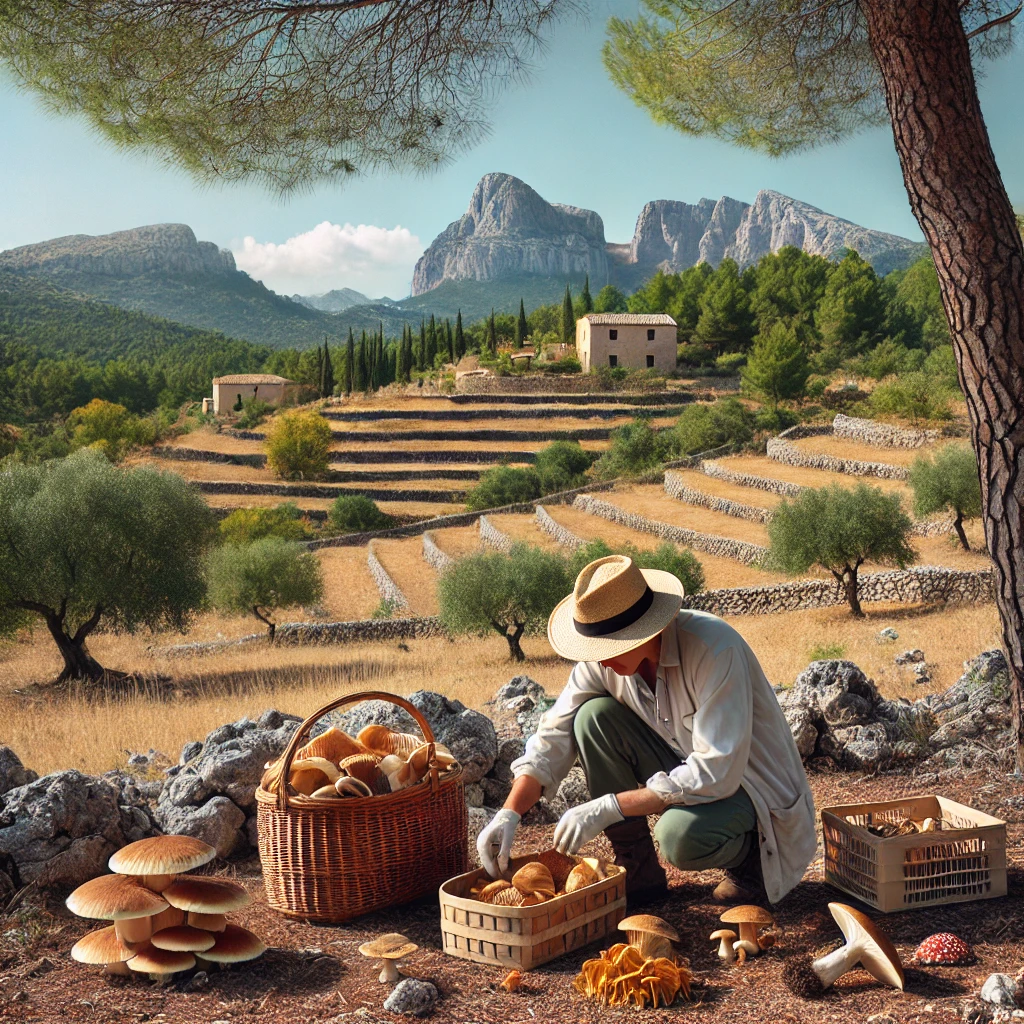The Mediterranean region is known for its beautiful coastlines, azure seas and rich culture. But off the beaten tourist track lies a fascinating world for nature lovers and gourmets alike: the world of mushrooms. With its mild climate and diverse vegetation, the Mediterranean region offers ideal conditions for an impressive variety of mushroom species. In this comprehensive guide, we take you on a journey through the forests and landscapes of the Mediterranean region, introduce you to 20 of the most interesting mushroom species and provide valuable tips for responsible mushroom picking. You can also expect delicious recipes and exciting information about the flora and fauna that you can discover on your forays.
Why pick mushrooms in the Mediterranean?
Climate and landscape
The Mediterranean region is characterized by a unique climate, which contributes significantly to the diversity of the mushroom world:
- Mild, damp winters: Ideal for the growth of mushrooms.
- Hot, dry summers: create special conditions for specific types of fungi.
- Transitional periods in spring and fall: peak season for mushroom pickers.
Diverse vegetation
The landscape is characterized by:
- Evergreen forests: Cork oaks, holm oaks and pines.
- Scrubland (maquis and garrigue): With shrubs such as rock roses and strawberry trees.
- Mountain regions and valleys: with mixed deciduous forests and chestnut groves.
Nature experience and culinary delights
- Discovering nature: mushroom picking takes you into untouched landscapes and allows you to observe animals.
- Culinary treasures: Fresh mushrooms are the basis for delicious dishes in Mediterranean cuisine.
The fascinating world of mushrooms in the Mediterranean region
Mushrooms and their importance
Fungi play a crucial role in the ecosystem:
- Decomposers: They break down organic material and promote soil fertility.
- Symbiotic partners: Many fungi live in close association with trees and plants.
20 important mushroom species in the Mediterranean region
We present 20 species of mushrooms that you can find in the Mediterranean region. Each species is described in detail, including its characteristics, habitats, plant partners and culinary uses.
1. blood irritant(Lactarius sanguifluus)
Description
- Cap: 5-15 cm, orange to wine-red, often with concentric rings.
- Lamellae: Cream-colored to orange, blood-red milky sap when injured.
- Stem: Short, firm, similar in color to the cap.
- Meat: Firm, blood-red milk comes out when cut.
Plant partners
- Symbiosis with pines: Especially Aleppo pine(Pinus halepensis) and black pine(Pinus nigra).
- Habitat: Calcareous soils in pine forests.
Culinary significance
- Popular edible mushroom: grilled, fried in olive oil or pickled.
- Tip: You can find accessories and literature at Funghi.es.
2. noble lactarius(Lactarius deliciosus)
Description
- Cap: 4-12 cm, orange to salmon-colored, concentric rings.
- Lamellae: Orange, denser.
- Handle: Cylindrical, hollow.
- Flesh: Orange-colored milk that turns greenish.
Plant partners
- Symbiosis with pines: Also spruces and firs.
- Habitat: Coniferous forests on acidic to neutral soils.
Culinary significance
- Spicy taste: ideal for frying or braising.
3. emperor mushroom(Amanita caesarea)
Description
- Hat: 8-20 cm, bright orange to red.
- Lamellae: Golden yellow.
- Stalk: Yellow, base surrounded by white volva.
- Flesh: Yellowish, mild.
Plant partners
- Symbiosis with oaks, chestnuts, beeches.
- Habitat: Deciduous forests in warm regions.
Culinary significance
- Delicacy: Can be enjoyed raw as a carpaccio.
- Caution: Danger of confusion with poisonous beads.
4. porcini mushroom(Boletus edulis)
Description
- Hat: 5-25 cm, light brown to dark brown.
- Tubes: Whitish to olive green.
- Stem: Strong, with a light-colored net.
- Flesh: White, firm, nutty flavor.
Plant partners
- Symbiosis with oaks, beeches, chestnuts and pines.
- Habitat: Mixed and deciduous forests.
Culinary significance
- Versatile use: soups, sauces, risottos.
5. chanterelle(Cantharellus cibarius)
Description
- Cap: 2-10 cm, funnel-shaped, yolk-yellow.
- Slats: Run-off instead of real slats.
- Stem: Yellow, firm.
- Aroma: Fruity apricots.
Plant partners
- Symbiosis with oaks, pines and beeches.
- Habitat: Mixed and coniferous forests.
Culinary significance
- Spicy taste: ideal for stir-fries and sauces.
6. parasol fungus(Macrolepiota procera)
Description
- Hat: 10-30 cm, open like an umbrella, brown scales.
- Lamellae: White, free-standing.
- Stem: Long, slender, flexible ring.
Plant partners
- Habitat: Meadows, forest edges, sparse forests.
Culinary significance
- “Schnitzel of the forest”: breaded and fried a delight.
7. morels(Morchella spp.)
Description
- Cap: honeycomb-like, 3-15 cm.
- Stalk: Whitish, hollow.
- Meat: Thin, aromatic.
Plant partners
- Habitat: Riparian forests, riverbanks, near ash and elm trees.
Culinary significance
- Gourmet mushroom: Ideal for fine sauces and soups.
8. truffle species(Tuber spp.)
Description
- Black truffles, summer truffles, white truffles.
Plant partners
- Symbiosis with oaks, hazelnut bushes and lime trees.
Habitat
- Calcareous soils in light-flooded forests.
Culinary significance
- Exclusive delicacies: Intense aroma, used in fine cuisine.
9. crested tintling(Coprinus comatus)
Description
- Cap: Cylindrical, white, scaly, melts to black.
- Lamellae: White, quickly turning black.
- Stem: Long, thin.
Plant partners
- Habitat: Meadows, roadsides.
Culinary significance
- Edible when young: Must be eaten fresh.
10. aniseed mushroom(Agaricus arvensis)
Description
- Hat: 8-20 cm, white to cream-colored.
- Lamellae: Pink, later brown.
- Handle: Thick, with large ring.
- Aroma: of aniseed or bitter almond.
Plant partners
- Habitat: Meadows, pastures.
Culinary significance
- Fine aroma: Similar to the cultivated mushroom.
11. purple ruddy knight(Lepista nuda)
Description
- Hat: 5-15 cm, purple.
- Lamellae: Purple.
- Stem: Purple, fibrous.
Plant partners
- Habitat: Mixed forests, deciduous litter.
Culinary significance
- Good edible mushroom: Must be well cooked.
12. ruffed hen(Sparassis crispa)
Description
- Fruit body: Cauliflower-like, cream-colored.
- Aroma: Nutty.
Plant partners
- Parasite on pine trees.
Culinary significance
- Excellent edible mushroom: firm flesh.
13. clove shrike(Marasmius oreades)
Description
- Hat: 2-5 cm, light brown.
- Lamellae: White to cream.
- Stem: Thin, tough.
Plant partners
- Habitat: Meadows, often forms witch rings.
Culinary significance
- Spicy aroma: ideal for soups.
14. pearl mushroom(Amanita rubescens)
Description
- Hat: 5-15 cm, reddish-brown.
- Lamellae: White, discoloring to pink.
- Stem: Whitish, reddens when injured.
Plant partners
- Symbiosis with oaks, beeches, pines.
Culinary significance
- Good edible mushroom: After sufficiently long cooking.
15. russulas(Russula spp.)
Description
- Hat: Variable in color.
- Lamellae: White to cream.
- Stem: White, brittle.
Plant partners
- Symbiosis with various trees.
Culinary significance
- Depending on the species, edible or inedible: taste test helps.
16th Giant Rusty(Stropharia rugosoannulata)
Description
- Hat: 10-25 cm, dark brown.
- Lamellae: Gray to purple.
- Stalk: Whitish, grooved ring.
Plant partners
- Habitat: Compost heaps, gardens.
Culinary significance
- Good edible mushroom: easy to cultivate.
17. greenling(Tricholoma equestre)
Description
- Hat: 5-10 cm, yellowish-green.
- Lamellae: Sulphur yellow.
- Stem: Yellow.
Plant partners
- Symbiosis with pine trees.
Culinary significance
- No longer recommended: Health risks.
18. mushrooms(Agaricus spp.)
Description
- Cap: Variable, white to brown.
- Lamellae: Pink to brown.
- Handle: With ring.
Plant partners
- Habitat: Meadows, gardens.
Culinary significance
- Edible or poisonous, depending on the species: be careful when identifying them.
19. yellow Leistling(Chroogomphus rutilus)
Description
- Hat: 4-10 cm, orange to reddish brown.
- Lamellae: Grayish purple.
- Handle: Curved.
Plant partners
- Symbiosis with pine trees.
Culinary significance
- Edible: Often used as a mixed mushroom.
20. anise mushroom(Agaricus silvaticus)
Description
- Cap: 5-10 cm, brown, scaly.
- Lamellae: Pink, later dark brown.
- Handle: Thin, with ring.
- Smell: Slightly of aniseed.
Plant partners
- Habitat: Coniferous forests.
Culinary significance
- Good edible mushroom: mild aroma.
Experiencing nature while picking mushrooms
Animal observations
You can observe many animals while collecting:
- Wild boar: In search of food.
- Roe deer and stags: In the woods.
- Birds: hoopoe, kingfisher, eagle.
- Reptiles: lizards, turtles.
Plant world
Discover:
- Mediterranean herbs: thyme, rosemary, sage.
- Wild orchids: Rare species.
- Flowering shrubs: rock roses, oleander.
Responsible mushroom picking
Safety tips
- Only pick known mushrooms: If in doubt, leave them standing.
- Equipment: basket, mushroom knife, sturdy shoes.
- Observe laws: Quantity limits, collection bans.
Respect for nature
- Sustainability: only collect as much as you need.
- Protection of the mycelium: remove the mushrooms carefully.
- Avoid waste: Leave nothing behind.
Mushrooms in Mediterranean cuisine
Blood irritant in garlic oil
A traditional dish that captures the flavors of the Mediterranean.
Porcini mushroom risotto
Creamy and aromatic, a classic of Italian cuisine.
Parasol schnitzel
Crispy fried, a vegetarian alternative to Wiener schnitzel.
Morel cream sauce
Fine and delicate, perfect with pasta or meat.
Drying and preserving mushrooms
- Drying: For a longer shelf life and more intense aroma.
- Pickle: In oil or vinegar, for antipasti and tapas.
- Freeze: For later use.
Growing mushrooms with Funghi.es
Offer
- Mushroom spawn and substrates: For various types of mushrooms.
- Instructions: For beginners and advanced users.
- Accessories: Everything you need for mushroom cultivation.
Advantages
- Fresh mushrooms all year round.
- Fun and education: Ideal for families and schools.
- Sustainability: home-grown reduces environmental impact.
Concluding thoughts
Mushroom picking in the Mediterranean is an enriching experience that combines the enjoyment of nature, culinary discoveries and adventure. With the necessary knowledge and respect for nature, you can enjoy the treasures of the forests responsibly.
Visit Funghi.es for more information, products and accessories related to mushrooms. Whether you are looking for high-quality medicinal mushrooms, grow accessories or expert advice – we are your partner for everything to do with mushrooms.
We wish you lots of fun and success on your next mushroom hunt in the Mediterranean!
Note: This article is for information purposes only. Always exercise caution when picking mushrooms. Consult a mushroom expert if you are unsure.


